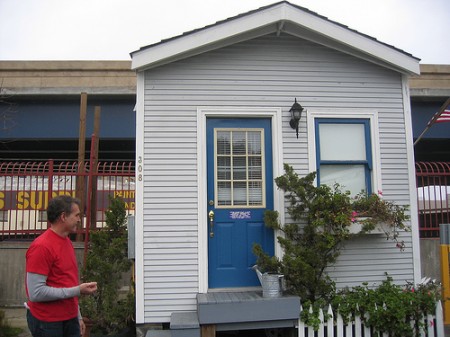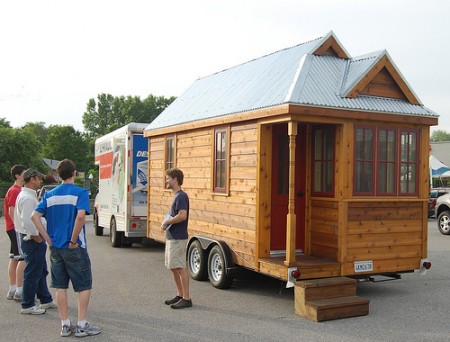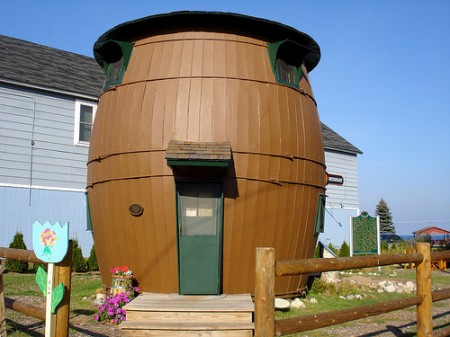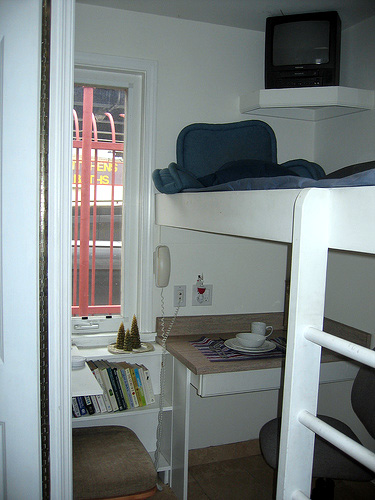How to Start Living in a Tiny House
This article appeared on wikiHow yesterday and I thought it was worth republishing here for you to read. Enjoy!
Living in a house smaller than some people’s walk-in closets may not be for everyone, but those who are able to do so reap many benefits for themselves and for the world around them. Here are some tips for choosing the best type of small house for you and how to simplify your life so living in a small house is enjoyable and not confining.
Steps
- Do your research. There are many types of tiny homes, from as small as 9 square feet up to 837 square feet. Look at the designs, which range from traditional to ultra-modern in design. Some incorporate off-the-grid designs like solar/wind power, rainwater collection, and composting toilets.
- Decide what you need from your dwelling and what you want from your dwelling. Most people need a comfortable, dry, quiet place to sleep; a clean place to perform personal hygiene (toilet, shower); a comfortable place to sit or lie down during the day; a place to store, prepare, and eat food for the day. You may want other creature comforts such as long-term refrigerated food storage, a clothes washer and dryer, a whirlpool tub, a state-of-the-art entertainment system, a power generator, a dishwasher, private bedrooms, workout facilities, wall-to-wall carpeting, granite countertops, T-3 internet access, and so on.
- Look at the benefits of “living small:” less space to clean; less pack-ratting of unneeded clothes, broken appliances, etc.; lower energy bills and a greener environmental footprint; fresher food that is purchased, caught, or harvested on a more daily basis; more time available for outdoor activities and entertaining; no need to sell your home when you relocate (if your tiny home is towable).
- Realize that small houses cost more per square feet than large houses. Designing for smaller areas is more complex, as items such as built-in furniture have to be custom made to take advantage of all the space. Compact appliances sometimes cost much more than full sized appliances. If you are designing or building your own home on a trailer bed, you need to take plumbing (grey water and black water storage and disposal) into consideration.
- Decide if you will build your own home from plans, or if you will buy an already made home new, or if you will buy a used home. There are also “kits” available which come with all or most of the supplies for building the house, along with instructions. The cheapest option for small living is to buy a well-maintained used RV or travel trailer. Craigslist usually will have several listings under $5000. You get the advantage of having something already designed and constructed, but you have the disadvantage of not being able to fully customize your home to your needs and wants.
- Pare down your belongings: we spend about 80% of our time wearing 20% of the clothes we own, so by getting rid of most of that wasted 80%, your life becomes immediately simpler: less laundry and less indecision about what to wear that day. Instead of having 3 TVs, 2 computers, a VCR, DVD, Blu-Ray, and 3 different game stations, reduce to one computer–transfer your movies to a hard drive and a flat screen monitor can double as a TV. A laptop with a TV tuner is even more energy efficient.
- Be creative about storage and multi-function furniture: a bed platform could have clothing storage drawers underneath. If you make a built-in sofa (without a bed) you can use the space underneath to store lots of things. A table can be made with shelves for storage underneath the table surface. Or you could design a table that folds out of the wall, then folds up and down to become a bed.
Video
A tour of a house that’s less than 100 square feet.
Tips
- Don’t try to cram too much stuff into your small home–it will make it appear very cluttered. This goes double for furniture: a full size sofa, a king size bed, a 6-person dinette and a large Club chair or reclining lounger won’t leave a lot of space for you to walk around. An armless sofa, double-size or queen-size bed in a loft, and a folding table with 2 folding chairs that would allow you to seat 4 for dinner (using the sofa as seating) is more reasonable.
- Build/design for your needs and prioritize your wants and add them one-by-one to the house until it is the perfect balance of desires and space.
- To “test drive” tiny house living, you can rent an RV for a limited period of time (like six months) and get a feel for what you need – and don’t need – in terms of space.
Warnings
- There is a substantial investment involved in building or buying a tiny home. Be sure you are physically and mentally prepared.
- Check local zoning codes for restrictions on minimum room size and RV/manufactured housing on residential lots. Many codes restrict houses to at least one room of 120 square feet and other rooms of a minimum 70 square feet. Some require the house to be built on a minimum percentage of the lot. You may be able to get exceptions granted to you, but be aware that many communities see small houses as something that depresses property values. Other communities see well-built smaller houses as something good for their infrastructure–less strain on the electric, sewer, and fresh water systems–and welcome them.
- Not everyone will share your enthusiasm for living small. They will think you to be a little crazy to live full-time in something that they would consider living in only for one or two weeks, a year at the most. If you are dating or married, be sure you and your partner are in full agreement on the subject of small living. If you are planning to have kids, be sure you know what will happen to your house at that time: will you build another small house and connect them together, or will you build a brand new house?
- Used RVs and manufactured housing are prone to water leaks, so check for any if you choose to buy something pre-owned. If you design or build your own house, be sure to pay attention for potentially damaging water leaks.
Article provided by wikiHow, a wiki how-to manual. Please edit this article and find author credits at the original wikiHow article on How to Start Living in a Tiny House. All content on wikiHow can be shared under a Creative Commons license.
If you enjoyed this post, subscribe to our feed





Excellent post Kent! Good details and information. Whenever someone can get a tour of a tiny house (like Jay’s) or rent a small house or trailer for a vacation or short living arrangement, it gives them a better idea about how they live and what they need in a tiny home.
An excellent overview of the practical and emotional aspects of small house life. A very good read.
“……as long as I have tiny plates, it seats four people” – that was just too funny.
Very good video, nice job.
I would think that living in an RV or a large tent for even a week would give someone a general idea of if they can do the small living long term.
Nice video. Renting a tiny (8×10) cabin (for several weeks) in the mountains of NC was my first intro to tiny house living and I can’t emphasize enough how important it is to have a good idea of what you really want to do in your home on a daily basis and to let that be your guide as to how much space you need. As a spinner and weaver, I dont think I’ll ever be able to live quite as tiny as Jay. I could spin on a spindle in my cabin, and even use a traveling wheel, but a loom? HA! the real beauty of the tiny house movement is how it helps us to ‘know ourselves’ better in a realistic way.
On the video tour, i would have gotten rid of the toaster oven (Unitasker! Sorry but i hate those!) in exchange for an RV size fridge with a little freezer.
Thanks for posting this! Great points!
Anyone know where i can find more info on the last photo?
You can view the story here. I never did a post on it because I was unable to get permission from the photographer. http://www.editorial.fnphoto.com/stories/2150/story.htm
There are move pictures at the bottom of the page if you click on “view story”
One thing not mentioned in this article is Ol’ Man Winter! If you are living tiny, especially in a manufactured camper, you need to be careful about your pipes. My husband and I lived full-time for 4 years in a 29′ travel trailer. We skirted it with styrofoam insulation boards and ran electrical tape from the ground up the water pipe. To further protect the water supply pipe, we built a tiny lean-to over the connection and, on the coldest days, we lit an incandescent bulb inside it.
As with any vehicle be sure to have it inspected before you decide about buying. A prepurchase vehicle inspection will cost about $100 and could save you thousands in repairs.
My immediate thought… where to park it while living in it. I can imagine problems with night-time pranksters, prowling about, ready to do damage or to harassing the occupant, just for the fun of it. Ideal targets for the adventurous 10-year-old with an easy-exit window in his ground-floor bedroom and an inattentive parent. Tiny houses are toys to play with, not living space for serious, responsible adults.
I’m struck repeatedly by the tiny house movement that the designers seem never to have looked at boat design. You want to see compact living spaces, look at small sailboats built for long distance voyaging. By small, I mean 25 to 35 feet (remember the ends taper and don’t hold much). And the vessels have to be able to be rolled over and keep crew safe. Lots of storage for crossing oceans. Completely self contained including energy, water, fuel, spare parts, books, clothing for various climates, sails, anchors and chain, engine, navigation and communication gear, etc.
Ours includes a queen size bed, two guest berths, dining for four, entertaining for eight, 3-burner stove and oven, refer, composting toilet and shower, solar and wind generation, diesel heating stove, water-maker and storage for months of cruising.
Most tiny house interiors I’ve seen pix of look absolutely clumsy by comparison.
Consider this 25 footer which could go around the world:
http://www.macnaughtongroup.com/penny_25_new_interior.htm
Or a little more extravagant 30 feet:
http://www.macnaughtongroup.com/sovereig.htm
When we finish cruising, we’ll be building a tiny house and using what we’ve learned to do so. The tiny house movement is vital to the future.
Everyone has made some good points on both sides of this subject. I have been a full timer in an RV for about a year now. I work, I’m educated and I’m much happier than I was with a mortgage. car payments and high utility bills looming over my head every month. Living n a small space is a huge change and not something that should be jumped into. I took small jaunts for a week at a time and worked up to a few months before I made the permanent change over. It is NOT for everyone. I share my tiny space with my boyfriend and he and I had to make some adjustments, for personal and emotional space.
I pay taxes for the RV and insurance as well.
Parking is usually not a problem. There are RV parks that are very reasonable.
For anyone that built a tiny house on property, most cities require a permit for any structure so of course there would be an assessment and taxes due.
As for worrying about what other people in your neighborhood think about your lifestyle, I believe that some are able to handle going against the grain a little and some who can’t.
Ultimately, it’s a personal choice. I prefer living small and having 0 debt. Everything I own is now paid for. The lack of stress has done wonders for my health.
Again, it’s not for everyone.
Hubby and I are getting ready to build a 14×30…I’m so ecxited NOT to have those high electric bills this winter. We live in an OLD house now and the bill got close to $700.00 last yr and we froze. NO MORE. We own the property so we have a place to put it.
i live in a space 18′ X 24′. that is my whole living space. it use to be a single car garage. i have slowly made it . i have compacted and keep compacting……what more can i do.?????????
Great tips! It’s a change for sure, but totally worth it.
Beautiful job making it cozy, Kent! I love your home!!
I think Jesus, said it best. “Live a simple life.”
I love Jay’s tiny house! It goes to show that you don’t have to relinquish “homey” living when you go tiny. Jay has created a very gracious home here. (I think he should become a tiny home interior design consultant.) I love the bathroom and his awesome idea to draw closed clear panels to convert it to a shower. (Where did Jay get the tiny fireplace? Too wonderful for words.)
http://www.castleton.co.uk/caverns/
I’m glad you pointed out that living in a tiny home makes moving so much easier! I’ve been interested in trying tiny home living, so I’ve been researching some of the benefits that the lifestyle provides. I didn’t realize that having a tiny home would mean relocating with virtually no hassle; thanks for pointing that out!
I liked your tip of not cramming stuff into a small home. My wife and I are wanting to downsize our living space and we were looking for some tips to help ease the process. I’ll be sure to tell her that we should try not to cram stuff into our smaller home.
My son and his girlfriend are wanting to build and move into a tiny house to save money and live more minimalistic. I appreciated your advice to build one based on your prioritized needs and use less furniture so it’s not crammed nor cluttered. I’ll talk with them on Sunday and let them know these tips and see if they need to buy a custom trailer to fit the needs of their home.
It’s great to learn that you’ll have lower energy bills when you live in a smaller house. My wife and I are wanting to have cheaper energy bills and we were wondering how we can change our lifestyle to pay less on our utilities. I’ll be sure to tell her that we should move to a smaller house to have lower energy bills.
It’s great to learn that you’ll have less space to clean when you move into a smaller home. My wife and I are starting our family and we were wondering how we could make it easier to clean the house with kids. I’ll be sure to tell her that we should consider moving to a smaller home to clean less.
Love this and it’s truly finding furniture to do double duty, multi-use items and hacks are the key to living happy in a tiny home!